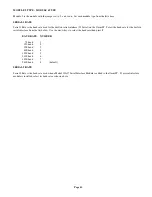
Page 29
DIGITAL COMMUNICATOR
The OmniLT digital communicator can use Contact ID, or Standard 4/2 or 3/1, (20 pps, 1800 Hz data, 2300 Hz handshake), or
(10 pps, 1900 Hz data, 1400 Hz handshake), dual round compared format. Any central station with modern equipment can
receive these formats. Compatible receivers are Ademco, Radionics, Osborne-Hoffman, Linear, FBI, and Silent Knight. It is up
to the installer to verify compatibility.
If the digital dialer does not get a handshake signal from the central station 45 seconds after it begins dialing, it hangs up and tries
again. The dialer will try the FIRST PHONE NUMBER 5 times, then go to the SECOND PHONE NUMBER and try that 5
times. After that, the system will indicate COMMUNICATIONS FAILURE on the console display and the digital communicator
will not try again until another reportable event occurs.
The digital communicator will not dial out until the DIAL OUT DELAY has expired. If the alarm is canceled prior to the
expiration of the DIAL OUT DELAY, no transmission will take place. After the DIAL OUT DELAY has expired, though, all
alarm trips will be transmitted followed by a CANCEL code.
When the digital communicator is used, all voice dial outs will be delayed for five minutes after the expiration of the dial out
delay to allow time for the central station to call the premises after an alarm code has been sent. If the digital communicator is
unable to successfully communicate with the central station, the user will be alerted to the trouble condition. When the system
status is requested using the voice, this condition is reported over the phone as "SECURITY PHONE MESSAGE" trouble.
DESCRIPTION OF CONTACT ID
Contact ID reporting allows very specific event codes to be sent to the central station. A complete report takes under three
seconds. Contact ID reporting uses predefined event codes that allow the central station to quickly identify the condition being
reported. The specific security zone or user code is identified as part of the report.
For each event code transmitted, the report also includes an event qualifier that identifies whether the report is for a new event
(such as a security zone trip), or a restoration of an event (such as a security zone no longer tripped). Trouble conditions are
reported, as well as restoration of these trouble conditions. For security armings and disarmings, this event qualifier is also used
to identify whether the report is for an arm or disarm. The reporting format for Contact ID is listed in Appendix A in this manual.
When using Contact ID, the alarm codes and/or reporting format cannot be changed. All alarm trips, regardless of Zone Type
(except Auxiliary Inputs), will be reported to the Central Station.
DESCRIPTION OF 4/2 FORMAT
The 4/2 format consists of a four-digit account code, from 0000 to FFFF and a two-digit alarm code from 00 to FF. When the
digital communicator calls the central station receiver, the latter answers and sends a brief 2300 Hz tone or a 1400 Hz tone called
a "Handshake" tone. The digital communicator then reports digits of the account and alarm codes as bursts of either (1800 Hz) or
(1900 Hz) tone; the digit 8 is represented by eight bursts of tone. A message, or "round" consists of an account code and an alarm
code. Two rounds are sent, and two consecutive rounds must match at the receiver. If they do, the central station receiver sends
another brief 2300 Hz or 1400 Hz tone to acknowledge to the digital dialer that the message has been properly received. If the
rounds don't match, the receiver does not send the second tone and the digital dialer tries again, up to 5 times. If the rounds are
not acknowledged after 5 tries, the digital dialer hangs up and tries the entire call again.
The digital communicator can report alarm zone trips, alarm cancels, low battery, and fire zone trouble. It may also be setup to
generate an automatic test signal at periodic intervals. The communicator may be setup to call second phone number using a
second account number in the event that it is unable to communicate successfully using the first phone number and account.
The digital communicator is setup at the factory to transmit a code when the battery is low or trouble with the fire zone is
detected. If these codes are set to 0 or 00, no code will be sent when the trouble condition is detected.
Although the alarm codes can be changed, we recommend that the alarm codes setup at the factory be used to minimize the risk of
installer error in programming the digital communicator. Simply enter the phone numbers and account codes, then verify the
alarm codes.
Содержание OmniLT Automation
Страница 1: ...Installation Manual Document Number 21I00 1 Rev A October 2000 ...
Страница 48: ...HAI New Orleans LA U S A ...
















































